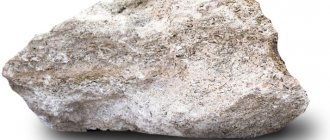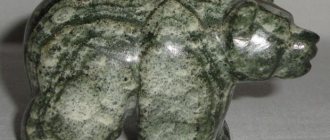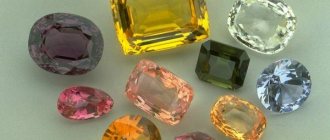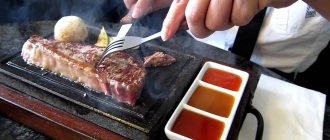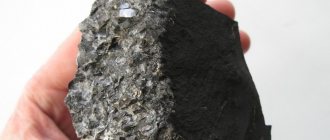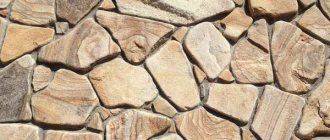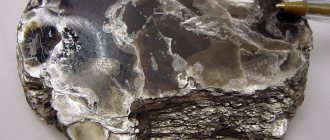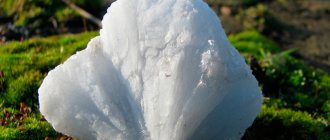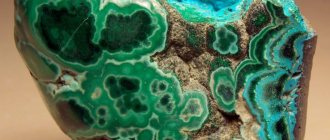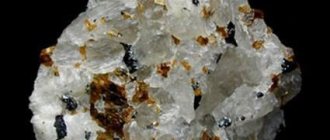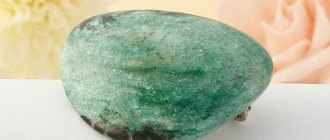History and origin
The history of man's use of stones of various types goes back thousands of years, because as soon as he began to recognize himself as a man, the need arose to build houses and roads, make dishes and jewelry. For this purpose, the hardest and most beautiful stones were used. One of these minerals was syenite - a massive, hard rock, similar in appearance to granite.
Mineral – Syenite
This stone began to be used in Ancient Greece. Near the city of Song, beautiful pinkish and gray stones were discovered that were perfect for building or lining houses and roads. C. Pliny then classified the mineral as a rock under the general name Siene. And several centuries after that, in Germany near the city of Dresden, G. Werner found similar stones and, based on ancient records and comparative analysis, gave it the name syenite.
In Russia, too, there are surprisingly interesting descriptions of syenite, left by Prince Kropotkin in the 19th century after a trip to Buryatia. He noticed that the mineral has a layered structure and alternates with granite.
Mineral mining
Syenite is often a companion of granite, and therefore it is usually found near its deposits - in the marginal zone - in the form of massifs and veins. The stone is classified as an igneous rock located deep underground, although, thanks to the ongoing internal life of the planet, it is now often found on the surface.
This breed is one of the most common on Earth and is found everywhere. Large deposits are located in North America (Arkansas and Wisconsin), Africa (South Africa, Kenya, Uganda), Brazil, Germany and the islands of Scandinavia.
In Russia, syenite deposits were discovered in the Trans-Baikal Territory, on the Yenisei Ridge and the Kola Peninsula. And in the Sayan Mountains there is a nature reserve called Krasnoyarsk Pillars. There, bizarrely shaped columns form an unearthly landscape. They are oddly shaped blocks stacked on top of each other.
Genesis and occurrence of the rock
The formation of nepheline syenite is associated with the processes of deep crystallization of magma depleted in silicic acid. It is also possible that some role in the formation of this rock belongs to alkaline metasomatic phenomena that took place in the contact zones of intrusive massifs, in particular, under the influence of feldspatizing (nephelinizing) hydrothermal solutions. As a result, the rock is greatly depleted in silicon, that is, practically devoid of quartz.
This rock is very common throughout the world. Its most common form of occurrence is large layered massifs (in the Krasnoyarsk Territory, the Urals, abroad - in South Africa, Canada, Greenland, Brazil). Intrusive bodies in the form of laccoliths are also common (for example, in the Khibiny Mountains on the Kola Peninsula) or stocks and veins cutting the host carbonate strata.
Physicochemical characteristics
Syenite, an intrusive holocrystalline rock, was formed as a result of volcanic activity that continued on Earth for many thousands of years. The movement of magma and its constant replenishment with new minerals formed the interesting structure of the stone - a combination of small and large mineral grains of different colors - pink, gray, green and dark.
The rock is most often formed by feldspar, dark-colored minerals and silica. And the concentration of acidic minerals makes syenite an alkaline rock.
Also read: Dunite - volcanic rock
| Property | Description |
| Hardness | 6 |
| Density | 2600 kg/m³ |
| Strength | 150-300 MPa |
| Brightness | 86% |
| Texture | Massive |
| Structure | Full-crystalline, uniformly crystalline, sometimes porphyritic, fine- and medium-grained |
| Mixing | Feldspar and dark-colored minerals |
| Form of occurrence | Dykes and rods |
| Genesis | Intrusive |
| Color | Light-colored rocks, grayish and pinkish, depending on the color of potassium feldspar and the content of dark-colored minerals |
Average chemical composition:
- SiO2 56-62%,
- TiO2 0.5-2%,
- Al2O3 14-19%,
- Fe2O3 1-4%,
- FeO 0.5-5%,
- MgO 0.2-3%,
- CaO 1-5.5%,
- Na2O 4-6.5%,
- K2O 4-9%.
Geologists often call the stone quartz-free granite due to the absence of the radiant mineral in its composition. This feature deprives the stone of its shine.
In general, syenite is very similar to granite, but it is more susceptible to weathering and has a lower strength level.
Taxonomy
Nepheline syenite is an intrusive rock. Its systematic characteristics are as follows:
- Class – plutonic rocks;
- Order – rocks of medium composition (silicic acid content from 52 to 63%);
- Suborder – moderately alkaline rocks;
- Family – syenites;
- The type of rock is syenite.
The adjective “nepheline” indicates a rock-forming mineral. Syenites can also be enstatite, hornblende, and so on.
Types of stone
Depending on the mineralogical composition, syenites are divided into types:
- Syenodierites (Diorites) are greenish-gray, medium-grained, speckled structure, in which all minerals are clearly visible: magnetite, ilmenite, apatite, common hornblende. This massive stone is used in construction due to its characteristics: high hardness, non-fragility, strength (it can only be cut with a diamond).
- Monzonites (Gabbro) are black, dark green, spotted, smooth, evenly granular in structure, rich in plagioclase, quartz, chromite and apatite. Gabbro is similar to diorite, but has a dark color. Used for the production of high-strength facing and building stones.
- Syenite - porphyry - gray, brown, containing large spar crystals, with a trachyte structure.
- Nepheline syenites are white, grayish, reddish and greenish, closely resembling granite with many components: potassium feldspar, granular nepheline, titanium, enigmatite, chlorine, fluorine, phosphorus and non-ferrous metals that determine the color of the stone. It is an alkaline intrusive rock.
The complex fluctuating composition of nepheline syenite determined the appearance of several types of this mineral:
- Khibinites. They occur in the Khibiny Mountains and have a complex coarse-grained structure.
Khibinit - Foyaites. A breed with large grains on a light gray background.
Foyait - Miaskites. A mineral with a wide range of colors: from gray to pink and dark gray. It contains zircon, corundum and garnets, which gives the impression that shine emanates through the thickness of the stone.
Miaskit - Rischorrites. Thanks to biotite, the stones have a noble color: from deep green to gray ocher.
- Luyavrites. Due to its oversaturation with alkalis, it has a black-green color and a banded structure.
Luyavrit
When weathered, nepheline syenite acquires a blue glow.
What is a stone?
Nepheline syenites are a family of alkaline intrusive holocrystalline rocks:
- The origin and other characteristics make the stone similar to granites or diorites. It is not for nothing that this group of syenites is classified as granitoids.
- But in its composition, unlike granite, there is no or almost no quartz, so the “granite” quartz sheen is also absent.
- Diorite differs from syenite in having a lower percentage of alkalis in its composition. Its density is higher and it is indifferent to weathering.
- In addition to nephelines, a common type of syenite is porphyry. These are coarse-crystalline gray-brown stones.
- An effusive analogue of nepheline stone with similar chemical composition and density is called trachyte.
The quantitative instability in the composition of nepheline and the variety of impurities exclude the presence of a single chemical formula for such syenite.
Scope of application of the mineral
All types of syenite are in demand by people in different areas of life, because the cost of processing them is minimal.
- Nepheline syenite, which in geology belongs to the group of framework silicates, is used
- Construction : as crushed stone for paths and areas near houses, internal and external cladding of houses, plinths, balconies, floors; in the production of anti-corrosion coatings for reinforced concrete structures.
- Chemical industry : in the production of cement, soda, alkali, glue, gels, paper and leather. Since the 30s of the 20th century, it has been widely used as a raw material for the production of alumina, necessary in the production of aluminum. It is classified as non-waste, because by-products: soda and sludge are used in the production of cement and silicate products, in the glass and ceramic industries. Modern technology makes it possible to simultaneously isolate rare chemical elements: gallium, rubidium and cesium.
- Agriculture : as part of highly effective fertilizers for acidic soils. Such fertilizers are created on the basis of potassium and without chlorine. They are absolutely harmless to soil, plants and humans. They reduce acidity, displace potassium and create conditions for plants to quickly absorb nutrients.
- Decorative purposes : for making sculptures, decorating fountains, stairs, making boxes, photo frames, writing sets
- Diorite, due to its color and structure, is used for the production of tabletops, pedestals, sculptures, steles, and monuments.
- Gabbro is used in construction in the form of stone tiles, crushed stone, chips, high-strength facing material, as a raw material for stone casting and in the production of mineral wool.
- Porphyry is one of the most durable rocks. They are a quarter harder than granite. This quality is used in construction and cladding. Cladding tiles or paving stones made from porphyry last 14-15 years, which is twice as long as granite tiles. Due to its high wear resistance, it is not afraid of impacts, sharp heels and scratches. And its low thermal conductivity makes it an excellent thermal insulation finishing natural material. Porphyry has the amazing property of self-cleaning. It allows the use of this mineral as a floor covering in factories and gas stations, in auto repair shops and car dealerships, where floor contamination with difficult-to-remove substances of oil origin is inevitable. The spots will disappear in 2-3 weeks. The production of facing slabs does not require additional processing, since the cut stone has a pattern created by nature itself.
Nepheline Syenite
The use of porphyry for decorative purposes is due to the natural beauty of the pattern and is used in the decoration of ceilings and swimming pools. Ceiling tiles made from this mineral can create the effect of ancient Roman buildings. The stone is beautifully painted, taking on any color.
Medicinal properties
Syenite is a product of the planet’s volcanic activity, which has accumulated earthly energy over millions of years. He is able to carry out constant energy exchange with a person. This helps to harmonize your internal state and establish peace of mind and balance.
The stone is widely used in Chinese and Tibetan medicine as a biostimulator on biologically active points of the body. And in Indian Ayurveda, small, smooth, round-shaped syenites relieve pain of various natures and localizations.
The stone has also found its use in traditional medicine. Polished gabbro is used during massage procedures. In spa salons, massage with a mineral heated to room temperature has a relaxing and restorative effect.
In folk medicine, it is believed that yellow and gray nepheline syenites have a beneficial effect on the gastrointestinal tract and increase appetite, while green and gray ones normalize the functioning of the nervous system and improve vision.
Magic properties
The stone is widely used in clairvoyance and extrasensory perception as a talisman. It reveals talent, increases abilities, helps expand the boundaries of the world around us, is effective in the hands of students, as it is able to help everyone who is drawn to something new, to discoveries, to knowledge of the Universe and its laws.
As an amulet, the mineral is protection against rash actions and hostile actions from the outside. Many astrologers claim that for Taurus and Aries, a small syenite placed above the entrance to the house will protect them from the evil eye and bad thoughts and create an atmosphere of love and prosperity.
Healing and magical effects
Esotericists and healers associate the paranormal capabilities of this type of syenite with nepheline.
The therapeutic effect is determined by the color of the mineral:
- Instances of the greenish-gray scale are beneficial for vision, calm the nerves, and relieve depression. To do this, place a pebble in front of you and simply contemplate.
- Yellowish-gray ones treat the gastrointestinal tract, improve digestion, and improve appetite. They are placed on the desired area of the body.
The magical properties of the mineral, according to esotericists, are generated by the volcanic origin of syenite:
- A stone mounted in the threshold of a house or mounted above the entrance to an apartment is a barrier against hostile external influences: damage, the evil eye, witchcraft, theft.
- This is a talisman for practicing clairvoyants or psychics.
- The mineral is capable of enhancing a person’s talents, revealing dormant abilities that a person did not even know about. To do this, the stone or a product made from it is placed on the desktop, bedside table, dressing table, under the pillow.
Astrologers consider nepheline syenite beneficial for Aries and Taurus.
Interesting things about the stone
- The world-famous sphinxes on the University Embankment in St. Petersburg are carved from syenite and are about three and a half thousand years old.
- Krasnoyarsk pillars made of pink syenite “grew” on the body of a huge monolith. Many millions of years ago, during violent magmatic activity, molten magma was able to break through cracks in it and froze on the surface, forming a magical picture.
Syenite cannot be classified as a precious stone. It is not used in expensive jewelry. But its value lies elsewhere: it was and will remain a symbol of the eternity and inviolability of Nature, reminiscent of the fragility and insecurity of man.
5 / 5 ( 1 voice )
Diorite
Diorite from the Greek word - I distinguish - an igneous deep-seated crystalline rock of gray or greenish-gray color.
It consists of plagioclase (oligoclase or andesine) and hornblende, less commonly augite and biotite, and sometimes quartz is present.
The structure is granite.
Some varieties contain quartz; in the latter case, diorite.
Hardness on the Mohs scale is about 6.
The color is greenish-gray with small white and black specks evenly distributed throughout the stone.
Compressive strength - 1800-2400 kg/cm2.
Solidity: average block size is about 1.0 m3.
It is used for the basement of buildings when a greenish-gray cladding color is required; It is also recommended for the manufacture of steps. Diorite was used in the cladding of the Khimki River Station in Moscow, formerly. Vorontsov Palace in Alupka, etc. Since diorite is poorly polished, it is unsuitable for cladding that requires a mirror texture.
Serves as a building material, some varieties are used in architecture and sculpture for making vases, etc.
